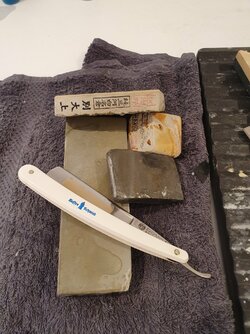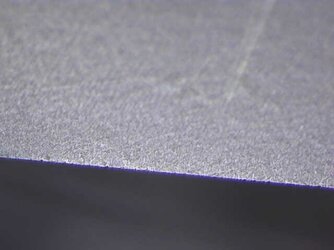I did a short honing experiment today. Questions;
Is my Mejiro coarser then my koma?
Dmt slurry on JNAT, how does it compare to the results from Asano naguras?
I jointed the edge and started with Méjiro.

I then moved on to Koma, and compared the results.
I found no difference using my stones.
The hard Mejiro felt a little better on this hard stone. They are just as fine.

I then jointed the edge carefully, and brought it back using a worn dmt 600 to generate slurry.
The diamond plate slurry gave deeper striations then the aforementioned nagura steps.

Finally the edge was finished with tomo slurry on a softer jnat.


This support my previous shave tests using these different approaches.
The nagura progression gives a smoother edge then the dmt slurried edge. However, the dmt slurried edge has a unique cutting feel to it. So, one is not better then the other, just different.
I would say that in terms of the best refinement, I would say the nagura progression sets the edge up better for the tomo finishing then the dmt slurried one.
Is my Mejiro coarser then my koma?
Dmt slurry on JNAT, how does it compare to the results from Asano naguras?
I jointed the edge and started with Méjiro.
I then moved on to Koma, and compared the results.
I found no difference using my stones.
The hard Mejiro felt a little better on this hard stone. They are just as fine.
I then jointed the edge carefully, and brought it back using a worn dmt 600 to generate slurry.
The diamond plate slurry gave deeper striations then the aforementioned nagura steps.
Finally the edge was finished with tomo slurry on a softer jnat.
This support my previous shave tests using these different approaches.
The nagura progression gives a smoother edge then the dmt slurried edge. However, the dmt slurried edge has a unique cutting feel to it. So, one is not better then the other, just different.
I would say that in terms of the best refinement, I would say the nagura progression sets the edge up better for the tomo finishing then the dmt slurried one.

